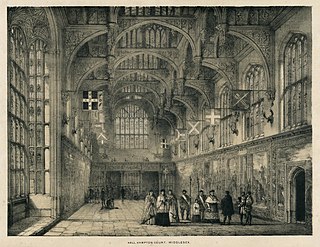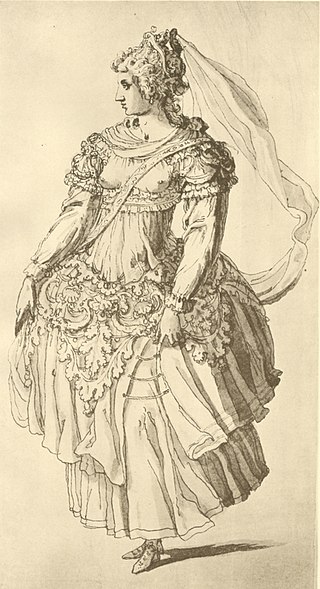
Bellott v Mountjoy was a lawsuit heard at the Court of Requests in Westminster on 11 May 1612 that involved William Shakespeare in a minor role.

Bellott v Mountjoy was a lawsuit heard at the Court of Requests in Westminster on 11 May 1612 that involved William Shakespeare in a minor role.
Stephen Bellott, a Huguenot, sued his father-in-law Christopher Mountjoy, a tyrer (a manufacturer of ladies' ornamental headpieces and wigs) for the financial settlement that had been promised at the time of his marriage with Mary Mountjoy in 1604: a dowry of £50, which had been promised but never paid, and an additional £200, to be bestowed upon Bellott in Mountjoy's will.
The records of the case were discovered in the Public Record Office (then in Chancery Lane, now part of the National Archives) in 1909 by the Shakespeare scholar Charles William Wallace and published by him in the October 1910 issue of Nebraska University Studies. The importance of this minor case is that Shakespeare was a material witness in it; his signed deposition of evidence was among the papers. Several of the other witnesses referred to Shakespeare's role in arranging the betrothal and in the negotiations about the dowry. He had been requested to take on the duties by Mountjoy's wife, Marie (who was also known as Mary, see note 1 ). The papers supply a roster of persons with whom Shakespeare was personally acquainted: the Mountjoys and their household and neighbours, including George Wilkins, the playwright and brothel-keeper who may have been Shakespeare's collaborator on Pericles, Prince of Tyre . The papers show that in 1604, Shakespeare was a lodger in the Mountjoys' house, at the corner of Silver and Monkwell Streets in Cripplegate, London. It is the only evidence yet found of a particular London address at which Shakespeare lived.
In his deposition, Shakespeare admitted that he had played the role as go-between in the courtship of Stephen Bellott and Mary Mountjoy that other witnesses described. However, he said that he could not remember the crucial financial arrangements of the Bellott/Mountjoy marriage settlement. [1] Without that key testimony, the Court of Requests remanded the case to the overseers of the London Huguenot church, which awarded Bellott 20 nobles (or £6 13s. 4d.). A year later, though, Mountjoy still had not paid. [2]
Charles Nicholl and others have identified Marie Mountjoy with the Mary Mountjoy, 1 born circa 1568, who was a client of the astrologer Simon Forman in 1597 (for example, after losing a ring). [3] [4]
The Mountjoys and Shakespeare may have met in the world of theatrical costuming. At the beginning of 1604, the year of her daughter's marriage, Mrs Mountjoy is known to have been working at court, where she provided a headpiece and trimmings for the queen, Anne of Denmark. The queen was taking the role of Pallas Athena in Samuel Daniel's masque The Vision of the Twelve Goddesses . [5]
The bill reads; "Marie Mountioye Tyrewoman for an helmett for her majestie and divers trymmings for her ladies in her maiesties maske at Twelftide 1603 as by her bill vouched by the La: Walsingham ... lix li [£59]. [6]
Mrs Mountjoy died in 1606. [7]

Handfasting is a traditional practice that, depending on the term's usage, may define an unofficiated wedding, a betrothal, or a temporary wedding. The phrase refers to the making fast of a pledge by the shaking or joining of hands.

The masque was a form of festive courtly entertainment that flourished in 16th- and early 17th-century Europe, though it was developed earlier in Italy, in forms including the intermedio. A masque involved music, dancing, singing and acting, within an elaborate stage design, in which the architectural framing and costumes might be designed by a renowned architect, to present a deferential allegory flattering to the patron. Professional actors and musicians were hired for the speaking and singing parts. Masquers who did not speak or sing were often courtiers: the English queen Anne of Denmark frequently danced with her ladies in masques between 1603 and 1611, and Henry VIII and Charles I of England performed in the masques at their courts. In the tradition of masque, Louis XIV of France danced in ballets at Versailles with music by Jean-Baptiste Lully.

Samuel Daniel (1562–1619) was an English poet, playwright and historian in the late-Elizabethan and early-Jacobean eras. He was an innovator in a wide range of literary genres. His best-known works are the sonnet cycle Delia, the epic poem The Civil Wars Between the Houses of Lancaster and York, the dialogue in verse Musophilus, and the essay on English poetry A Defense of Rhyme. He was considered one of the preeminent authors of his time and his works had a significant influence on contemporary writers, including William Shakespeare. Daniel's writings continued to influence authors for centuries after his death, especially the Romantic poets Samuel Taylor Coleridge and William Wordsworth. C. S. Lewis called Daniel "the most interesting man of letters" whom the sixteenth century produced in England.
George Wilkins was an English dramatist and pamphleteer best known for his probable collaboration with William Shakespeare on the play Pericles, Prince of Tyre. By profession he was an inn-keeper, but he was also apparently involved in criminal activities.
Robert Johnson was an English composer and lutenist of the late Tudor and early Jacobean eras. He is sometimes called "Robert Johnson II" to distinguish him from an earlier Scottish composer. Johnson worked with William Shakespeare providing music for some of his later plays.

Simon Forman was an Elizabethan astrologer, occultist and herbalist active in London during the reigns of Queen Elizabeth I and James I of England. His reputation, however, was severely tarnished after his death when he was implicated in the plot to kill Sir Thomas Overbury. Astrologers continued to revere him, while writers from Ben Jonson to Nathaniel Hawthorne came to characterize him as either a fool or an evil magician in league with the Devil.

William Shakespeare was an actor, playwright, poet, and theatre entrepreneur in London during the late Elizabethan and early Jacobean eras. He was baptised on 26 April 1564 in Stratford-upon-Avon in Warwickshire, England, in the Holy Trinity Church. At the age of 18, he married Anne Hathaway, with whom he had three children. He died in his home town of Stratford on 23 April 1616, aged 52.

The Masque of Blackness was an early Jacobean era masque, first performed at the Stuart Court in the Banqueting Hall of Whitehall Palace on Twelfth Night, 6 January 1605. It was written by Ben Jonson at the request of Anne of Denmark, the queen consort of King James I, who wished the masquers to be disguised as Africans. Anne was one of the performers in the masque along with her court ladies, all of whom appeared in blackface makeup. In a ceremony earlier on the day, Prince Charles, Anne's second son was given the title of Duke of York.

Charles William Wallace was an American scholar and researcher, famed for his discoveries in the field of English Renaissance theatre.

The Vision of the Twelve Goddesses was an early Jacobean-era masque, written by Samuel Daniel and performed in the Great Hall of Hampton Court Palace on the evening of Sunday, 8 January 1604. One of the earliest of the Stuart Court masques, staged when the new dynasty had been in power less than a year and was closely engaged in peace negotiations with Spain, The Vision of the Twelve Goddesses stood as a precedent and a pattern for the many masques that followed during the next four decades.

Susan Herbert, Countess of Montgomery, was an English court office holder. She served as lady-in-waiting to the queen consort of England and Scotland, Anne of Denmark. She was the youngest daughter of Elizabethan courtier, and poet Edward de Vere, 17th Earl of Oxford.

The spelling of William Shakespeare's name has varied over time. It was not consistently spelled any single way during his lifetime, in manuscript or in printed form. After his death the name was spelled variously by editors of his work, and the spelling was not fixed until well into the 20th century.
Sir Edward Zouch of Woking was a courtier to English kings James and Charles I, a masque actor, and Knight Marshal of the King's Household.
Elizabeth Howard, Lady Knollys, courtier to Anne of Denmark.
Sir Richard Dyer of Staughton, was an English courtier, soldier, and landowner.
Silver Street was a street in London. It ran from the north end of Noble Street at Falcon Square to Wood Street. It originated in medieval times, and is one of the streets shown on a map known as the "Woodcut map of London" or the "Agas" map, which survives in a 17th-century version.

The Masque of Indian and China Knights was performed at Hampton Court in Richmond, England on 1 January 1604. The masque was not published, and no text survives. It was described in a letter written by Dudley Carleton. The historian Leeds Barroll prefers the title, Masque of the Orient Knights.
William Portington (1544-1628) was an English carpenter and joiner, originally from St Albans, employed by Elizabeth I and James VI and I. He was master carpenter of the Office of Works.
Christophe de Harlay, Count of Beaumont (1570–1615) was a French politician and diplomat who served as ambassador to England.

Christopher Shawe or Shaw was an English embroiderer and textile artist who worked on masque costume for Anne of Denmark. He was a member of the Worshipful Company of Broderers.